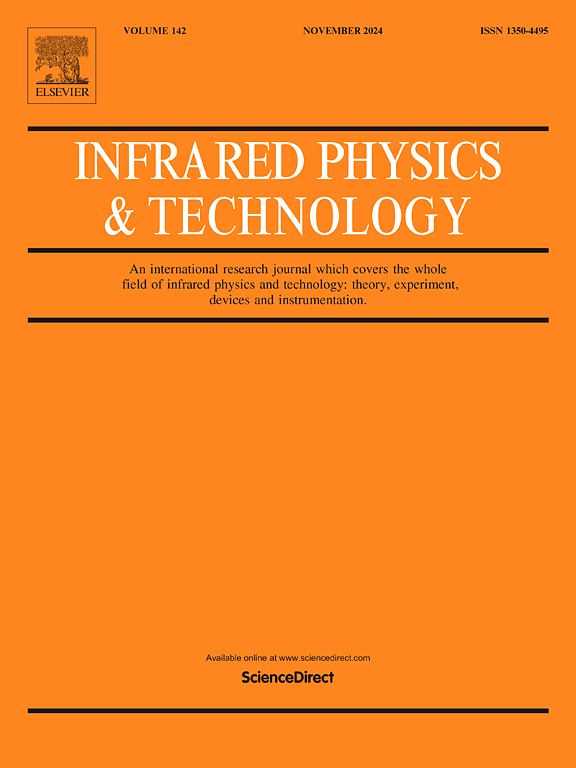Strong green upconversion luminescence of rare earth Yb3+/Er3+ co-doped Ca3(VO4)2 phosphor for optical sensing
IF 3.1
3区 物理与天体物理
Q2 INSTRUMENTS & INSTRUMENTATION
引用次数: 0
Abstract
A novel upconversion phosphor, Ca3(VO4)2 co-doped with Yb3+ and Er3+, was successfully synthesized via a high-temperature solid-state method. Under 980 nm near-infrared excitation, this material exhibits remarkable upconversion luminescence, with intense green emissions at 527 nm and 550 nm, and a weaker red emission at 657 nm. The optimal doping concentrations were determined to be 0.03 for Yb3+ and 0.005 for Er3+, enabling maximum luminescent efficiency. Spectroscopic investigations including upconversion photoluminescence, excitation, and emission spectra confirmed that the upconversion follows a distinct energy transfer mechanism: Yb3+ (2F5/2) + Er3+ (4I11/2) → Yb3+ (2F7/2) + Er3+ (4F7/2). In addition to its excellent luminescent properties, the Ca3(VO4)2: 0.03Yb3+/0.005Er3+ phosphor exhibits reliable optical thermal sensitivity over a wide temperature range (298–673 K), with a peak relative sensitivity of 1.11 % K−1 at 298 K. These outstanding optical characteristics make Ca3(VO4)2: 0.03Yb3+/0.005Er3+ a promising candidate for display and lighting technologies.

稀土Yb3+/Er3+共掺Ca3(VO4)2荧光粉的强绿色上转换发光光学传感
采用高温固相法成功合成了Yb3+和Er3+共掺杂的新型上转换荧光粉Ca3(VO4)2。在980 nm近红外激发下,该材料表现出显著的上转换发光,在527 nm和550 nm处有强烈的绿色发射,在657 nm处有较弱的红色发射。Yb3+的最佳掺杂浓度为0.03,Er3+的最佳掺杂浓度为0.005,可以获得最大的发光效率。光谱研究包括上转换光致发光、激发和发射光谱,证实了上转换遵循一个独特的能量传递机制:Yb3+ (2F5/2) + Er3+ (4I11/2)→Yb3+ (2F7/2) + Er3+ (4F7/2)。除了具有优异的发光性能外,Ca3(VO4)2: 0.03Yb3+/0.005Er3+荧光粉在298 - 673 K的宽温度范围内表现出可靠的光学热敏性,298 K时的峰值相对灵敏度为1.11% K−1。这些突出的光学特性使Ca3(VO4)2: 0.03Yb3+/0.005Er3+成为显示和照明技术的有前途的候选者。
本文章由计算机程序翻译,如有差异,请以英文原文为准。
求助全文
约1分钟内获得全文
求助全文
来源期刊
CiteScore
5.70
自引率
12.10%
发文量
400
审稿时长
67 days
期刊介绍:
The Journal covers the entire field of infrared physics and technology: theory, experiment, application, devices and instrumentation. Infrared'' is defined as covering the near, mid and far infrared (terahertz) regions from 0.75um (750nm) to 1mm (300GHz.) Submissions in the 300GHz to 100GHz region may be accepted at the editors discretion if their content is relevant to shorter wavelengths. Submissions must be primarily concerned with and directly relevant to this spectral region.
Its core topics can be summarized as the generation, propagation and detection, of infrared radiation; the associated optics, materials and devices; and its use in all fields of science, industry, engineering and medicine.
Infrared techniques occur in many different fields, notably spectroscopy and interferometry; material characterization and processing; atmospheric physics, astronomy and space research. Scientific aspects include lasers, quantum optics, quantum electronics, image processing and semiconductor physics. Some important applications are medical diagnostics and treatment, industrial inspection and environmental monitoring.

 求助内容:
求助内容: 应助结果提醒方式:
应助结果提醒方式:


